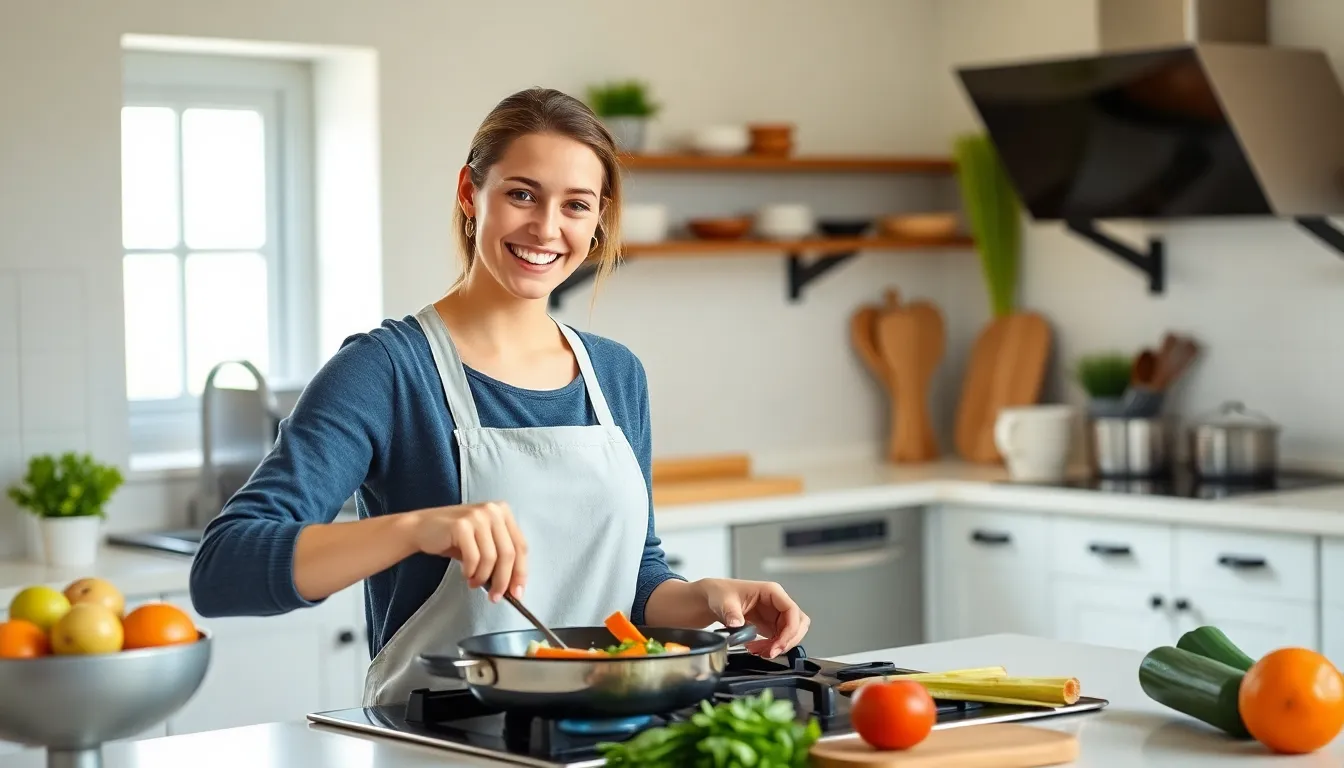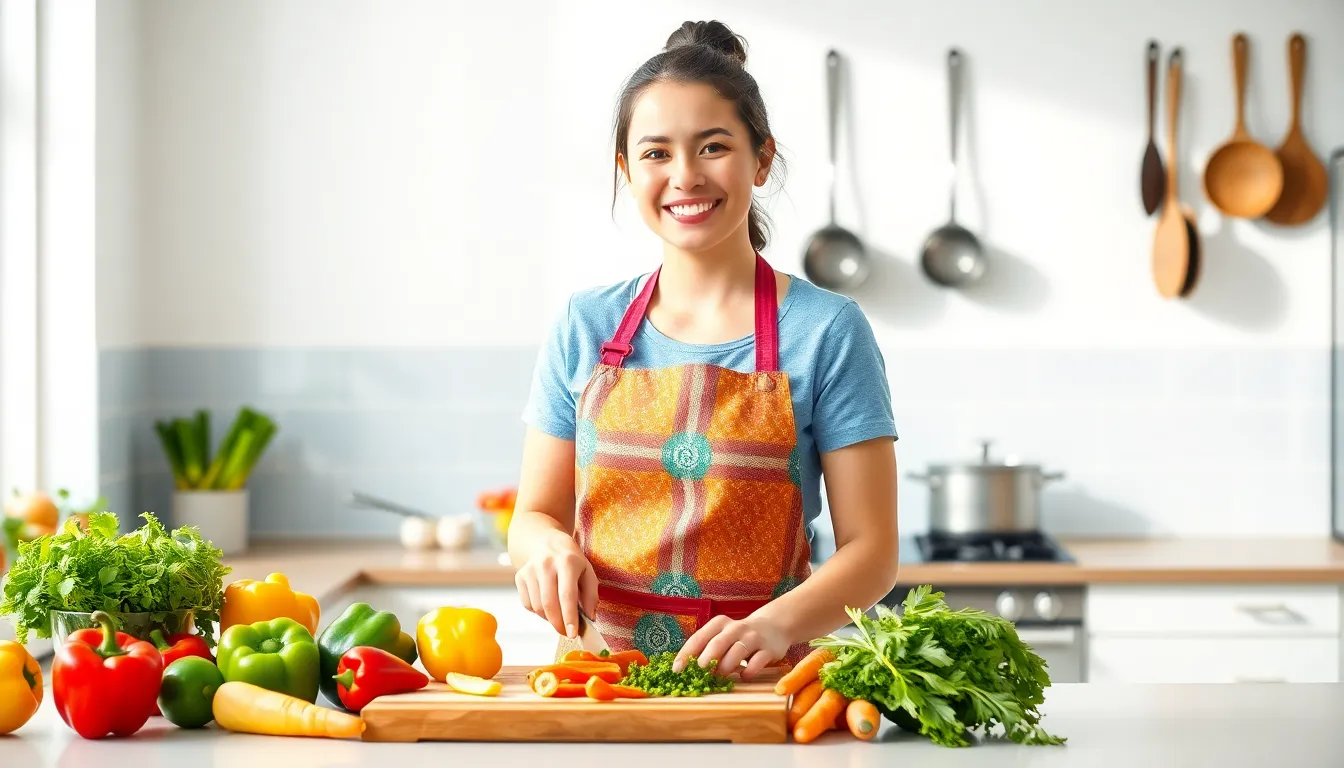Cooking can feel like a daunting task, especially for beginners armed with little more than a spatula and a dream. But fear not! Mastering the kitchen doesn’t require a culinary degree or a secret family recipe. With a few essential techniques, anyone can go from microwave meals to gourmet creations that even Gordon Ramsay would approve of—well, maybe not the yelling part.
Table of Contents
ToggleUnderstanding Cooking Techniques
Cooking techniques form the backbone of successful meal preparation. Grasping these methods empowers beginners to navigate the kitchen with confidence.
Boiling involves cooking food in water or broth at high temperatures, effectively extracting flavors. This method suits pasta, vegetables, and eggs.
Sautéing utilizes a small amount of oil in a hot pan, allowing ingredients like vegetables and proteins to cook quickly. Adjusting heat prevents burning while delivering optimal flavor.
Baking employs dry heat in an oven. This technique suits bread, cakes, and casseroles, yielding a consistent cook throughout the dish. Understanding oven temperature ensures desired results.
Grilling exposes food to direct heat, creating a characteristic char. Meats, vegetables, and fruits benefit from this method, enhancing flavor and texture through caramelization.
Steaming involves cooking food with steam, preserving nutrients and moisture. This method benefits vegetables and fish, offering a healthy cooking option free of added fats.
Roasting combines dry heat with hot air circulation for even cooking. This technique works well for meats and root vegetables, producing rich flavors and appealing textures.
Frying can be divided into shallow and deep methods, with oil crucial for flavor and texture. Beginners should monitor oil temperature to achieve the perfect crispiness.
Poaching gently cooks food in simmering liquid, retaining delicate flavors. Eggs and fish often benefit from this method, resulting in tender textures.
Learning these basic techniques enables beginners to adapt recipes and create diverse meals. Mastering them fosters culinary creativity and builds confidence in the kitchen.
Essential Cooking Techniques for Beginners

Beginners can enhance their cooking skills by mastering a variety of essential techniques. Understanding these methods promotes confidence and creativity in meal preparation.
Boiling and Simmering
Boiling involves cooking food in water at a temperature of 212°F. This method quickly cooks pasta or vegetables, making them tender. Simmering, on the other hand, occurs at a lower temperature, around 180°F to 200°F. This technique allows flavors to meld in soups and sauces. Both methods provide a foundation for understanding how to control cooking temperatures. Utilizing a lid can also speed up the cooking process and conserve energy, allowing for efficient meal prep.
Sautéing
Sautéing means cooking food quickly in a small amount of oil over medium-high heat. This technique allows for browning and developing flavors in meats and vegetables. Choosing the right pan, such as a skillet, ensures even heat distribution. Beginners can start with garlic or onions, which impart flavor to the oil. Stirring the ingredients frequently prevents burning and promotes even cooking, enhancing the dish’s overall taste and texture.
Baking
Baking refers to cooking food in an oven through dry heat. This technique typically involves using moderate temperatures, ranging from 325°F to 375°F. Precise measurements are crucial for baking, as even slight deviations can impact the final product. Utilizing parchment paper can prevent sticking and promote even cooking. Understanding baking times is essential for achieving the desired texture, whether soft or crunchy, allowing for a variety of baked goods like bread, pastries, and casseroles.
Preparing Ingredients for Cooking
Preparing ingredients sets the foundation for successful dishes. Proper preparation enhances flavor and texture while saving time during cooking.
Chopping and Cutting
Chopping and cutting require sharp knives for efficiency. A chef’s knife works well for various tasks, from dicing onions to slicing vegetables. Different cutting techniques, like julienne and chiffonade, produce specific shapes, affecting the cooking process. Practice consistent sizes to ensure even cooking. Additionally, using a cutting board prevents slips and protects surfaces. Remember to keep fingers tucked away to avoid accidents. Knowing how to properly sanitize knives and cutting boards reduces the risk of cross-contamination.
Marinating
Marinating boosts flavor by allowing food to soak in seasonings. Acidic ingredients, like vinegar or citrus juice, tenderize meats while adding zest. Combine herbs and spices in a mixing bowl, then coat the protein or vegetables evenly. Allow marinating for at least 30 minutes, but longer durations yield richer flavors. Refrigeration is crucial during this time to prevent spoilage. Marinated foods shine on the grill, enhancing the overall taste of the dish. Understanding marinating principles equips beginners with techniques to elevate their culinary creations.
Practicing Safety in the Kitchen
Practicing safety in the kitchen ensures a positive cooking experience. Initiating safe habits early helps prevent accidents and promotes better food handling.
Knife Safety
Knife safety remains crucial for beginners. Always use a sharp knife, as it requires less pressure and is less likely to slip. Cutting boards should be stable, preventing movement during use. Keep fingers tucked away from the blade while slicing. Positioning hands away from the cutting path minimizes the risk of injury. When passing a knife, always lay it down instead of handing it directly to someone. Storing knives safely, like in a block or on a magnetic strip, reduces the chance of accidental cuts.
Food Safety Tips
Food safety tips are vital to maintaining health in the kitchen. Wash hands thoroughly before and after handling food to prevent contamination. Store raw meats separately in the refrigerator to avoid cross-contamination. When cooking, use a food thermometer to ensure meats reach safe internal temperatures, such as 165°F for poultry. Refrigerate leftovers promptly, ensuring they cool within two hours of preparation. Following these guidelines safeguards against foodborne illnesses, enhancing the cooking experience.
With a solid understanding of fundamental cooking techniques beginners can confidently navigate their way through the kitchen. Embracing methods like boiling sautéing and baking opens up a world of culinary possibilities. As they practice these skills their confidence will grow allowing for creativity and experimentation in meal preparation.
Prioritizing ingredient preparation and kitchen safety further enhances the cooking experience ensuring delicious results and a safe environment. Each dish created not only satisfies hunger but also serves as a stepping stone toward becoming a more skilled and adventurous cook. By taking these initial steps beginners will find joy in cooking and the satisfaction of mastering new techniques.




